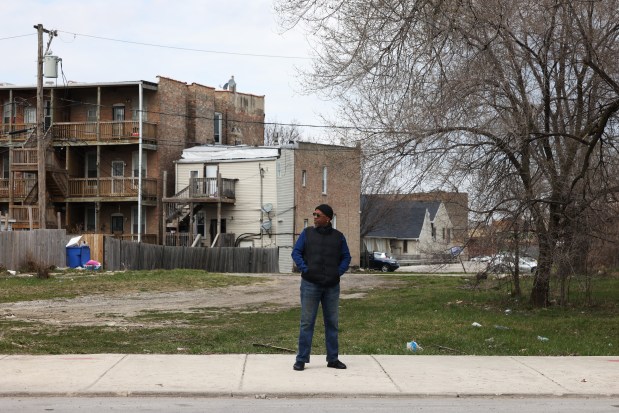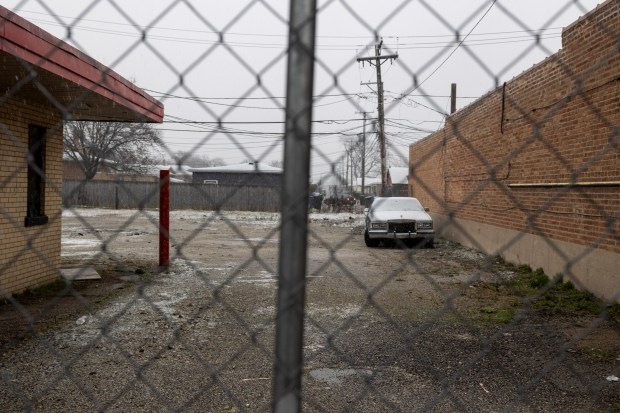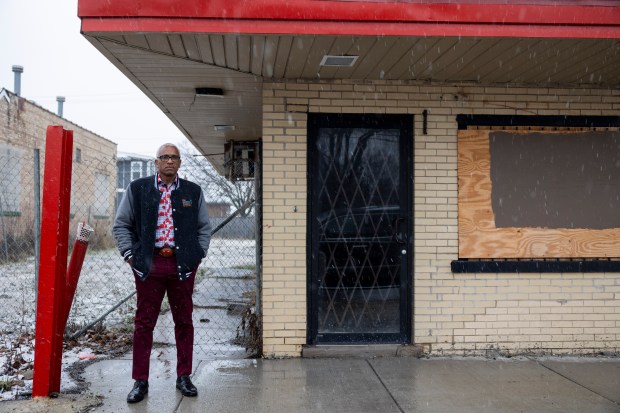More than one-third of vacant lots in Chicago are close to “L” stations, a new report shows, creating challenges for neighborhoods and the CTA alike.
And most of those vacant lots are in predominantly Black communities, a glaring symbol of historic disinvestment, according to the report from transit-focused development collaborative Elevated Chicago, the Institute for Housing Studies at DePaul University and community groups.
The city has long been plagued by vacant lots, often concentrated in Black neighborhoods. But vacant land near the CTA poses additional challenges. Sometimes breeding environmental hazards and safety concerns, unmaintained vacant lots can limit how willing residents are to walk to transportation and other neighborhood amenities, shaping when and how residents take public transit and the ability of transit, often considered a neighborhood asset, to connect communities to the rest of the city.
And vacant lots’ proximity to public transportation has taken on increasing importance as the city has tried to spur development near bus and train lines, including recently a direct focus on the South and West sides.
In 2022, aldermen approved the newest version of the city’s transit-oriented development ordinance, which officials said at the time was intended to address gentrification and undo inequities that came from earlier versions of the policy, which led to the vast majority of development near transit taking place in areas tsuch as he North Side, Near Northwest Side, West Loop and downtown.
But outside those areas, city- and privately owned land that now sits vacant holds dormant potential to be put to uses that could draw transit riders and residents out into the community, the report’s authors said. For example, the busy 95th Street Red Line station is a hub for train and bus riders — and the planned extension of the Red Line south from the station to 130th Street has brought focus on development in the area — but vacant land nearby doesn’t give riders a reason to leave the station and spend money out in the community, said Marly Schott with Elevated Chicago.
Charles Perry hopes to change that by opening an ice cream shop nearby. But he worries about the empty lots in the area.
“Just the vacant lots, for the community itself, is demeaning,” he said. “It says that we don’t value this space that we have.”
In the report, the Institute for Housing Studies analyzed vacant lots owned by the city and private entities, proximity to CTA train stations, and the racial and ethnic makeup of the areas where the lots were found. The organization studied vacant lots as of July 2023, and considered them close to transit if they were within a half-mile of an “L” station.
They found the communities that had among the most vacant lots near transit included Englewood and West Englewood, home to the terminus of one branch of the CTA Green Line. Also topping the list were East and West Garfield Park, served by two CTA train lines, and North Lawndale, served by the Pink Line.
Elevated Chicago and community groups then zeroed in on two areas, East Garfield Park, and Roseland and Washington Heights, talking to residents who expressed concerns about maintaining housing affordability as vacant land is developed, the challenges of navigating city programs to redevelop vacant lots, and the desire to see developments include amenities like grocery stores.
The data showed more than 14,700 vacant lots in the city were close to a CTA train station as of July 2023. Nearly 74% of the lots were within predominantly Black communities.
That includes more than 1,500 vacant lots in East Garfield Park, where Brian Ellison lives. Though his home is blocks from the Green Line, he and his wife rarely take public transit. His wife doesn’t feel comfortable walking to and from transit, past vacant lots, he said.
“It just feels kind of desolate,” he said.

Maintaining the affordability of the neighborhood as the lots are developed is key to Ellison, who has worked with Elevated Chicago and leads the board of neighborhood group Garfield Park Community Council. Stabilizing the neighborhood can recapture a sense of safety and pride for residents, he said.
He is excited about an affordable housing development in the works nearby called Fifth City Commons, for which he consulted with the developer, but said more commercial development is needed in the neighborhood, along with parks and green space. And he feels strongly that continued efforts should be made to avoid pushing out longtime residents as lots are developed.
The report also found most vacant lots near transit were privately owned, but more than 25% were owned by the city. While figuring out who owns private lots and working with the entities can be complicated, the city has control of how its own lots might be used, said Geoff Smith, executive director of the Institute for Housing Studies.
The city has long owned vacant land in predominantly Black communities, but a high concentration of that land is near transit, Smith said. Some 90% of city-owned vacant lots near transit are in Black communities, a share Smith said was surprising.
The lots’ proximity to transit is an incentive for development, said Peter Strazzabosco, a spokesman for the city’s Department of Planning and Development, in a statement. He pointed to projects that have used city-owned land for development near transit, such as a mixed-income residential and commercial development near the Green Line near Bronzeville and a residential development in the works near the Green Line in Englewood.
“The lots are opportunities more than barriers,” he said, citing city incentives and grants for development near transit and programs to encourage development of vacant lots.
The city’s transit-oriented development policy can help shape what happens to the lots, but the city can also work to better connect residents to opportunities to put the vacant land in their communities to use, Schott said. Also key to the process will be working with communities to make sure residents aren’t displaced by gentrification, Schott said.
In the meantime, the sheer number of vacant lots surrounding transit was “staggering” to Schott. And the potential held by hundreds of empty lots in a single community is vast, she said.

Vacant lots can pose environmental hazards and sites for increased crime, Schott said. Near transit the effects can go further, limiting how safe both visitors to a community and residents feel walking to and from train stations, shaping decisions on how to get around the city and where to go. That can force residents to feel like they need to own a car, and limit the number of riders on CTA, she said.
“The safer our transit is, the more people will take it, and the more people will move throughout the city to areas they might not have otherwise,” she said. “The more areas around transit are developed, the more people will come to communities to visit those communities, those cultural centers, those green spaces.”
In the community around the 95th Red Line station, where Perry recently bought his building, 220 lots near transit are vacant. The area around the bustling station should be clean and well kept, but vacant lots are often used for illegal dumping and can spur violence, said Perry, a community advocate who helped survey lots for the study with a group of formerly imprisoned people.
Perry said he grew up in Washington Heights near the Red Line and was sentenced to 25 years in prison in 1989 after dealing drugs. Out of prison for more than a decade, he returned to buy a building in the area in an attempt to restore the community he feels he once helped harm.
He plans to turn the building into an ice cream shop and a space for a nonprofit he said he runs. But vacant lots surrounding well-kept homes and businesses can bring down property values, a frustration for longtime homeowners in the area, he said.
“You’re going to the store you’ve got a number of vacant lots, you go to transit you’ve got a number of vacant lots,” he said. “All of that is just an eyesore for a community, when you can look at communities around the city of Chicago that don’t have that kind of environment.”
But there could be a silver lining. The city has focused on development in the area around the 95th Street station, and while repurposing vacant lots will not be without challenges, they could present an opportunity, said Hubert Morgan with the Endeleo Institute, which also worked on the study.
“The slate is clean,” he said. “You can look at it positively in that regards. The slate is clean for opportunities for revitalizing a corridor that has the most people embarking and disembarking at a train station.”





